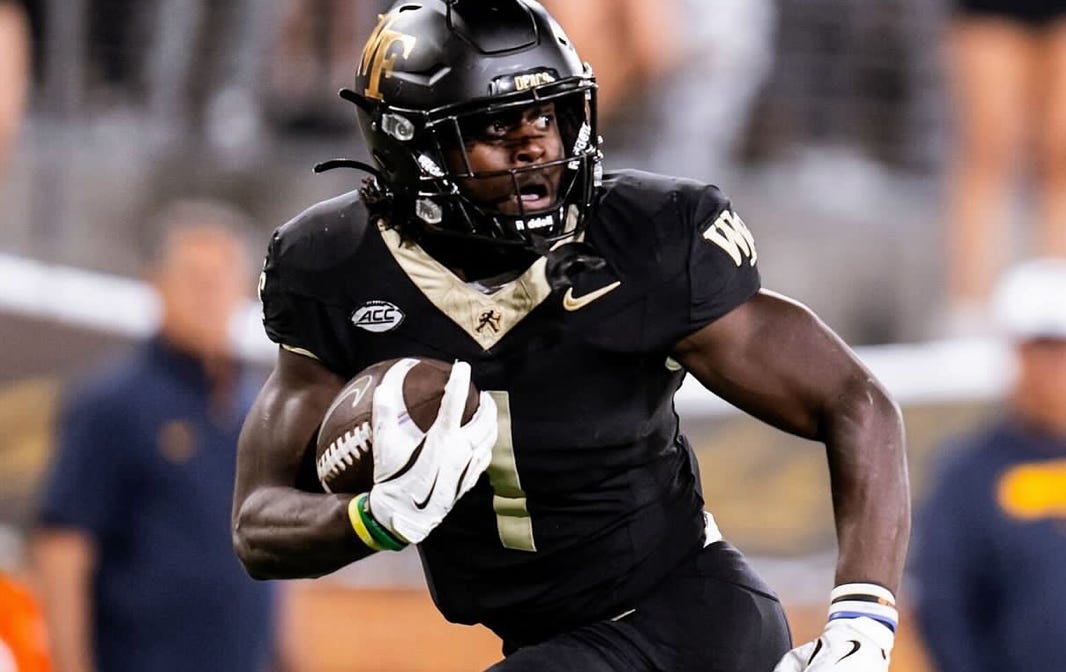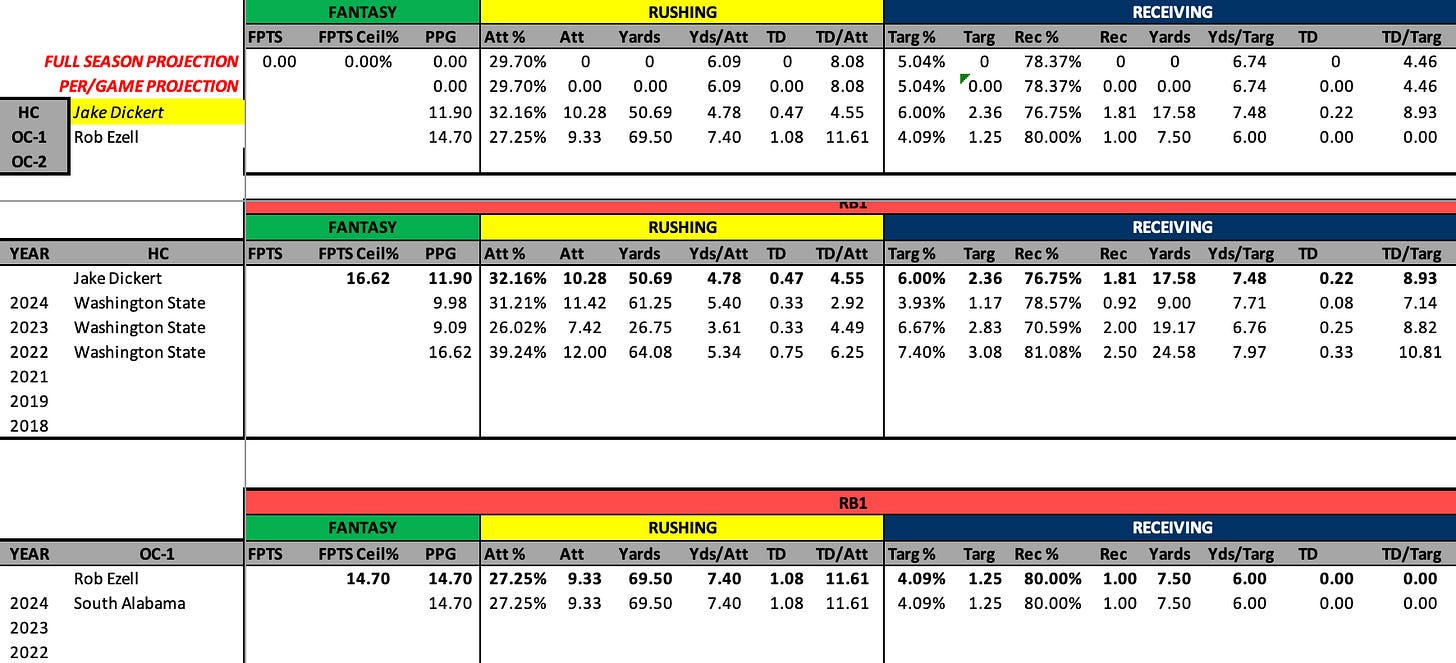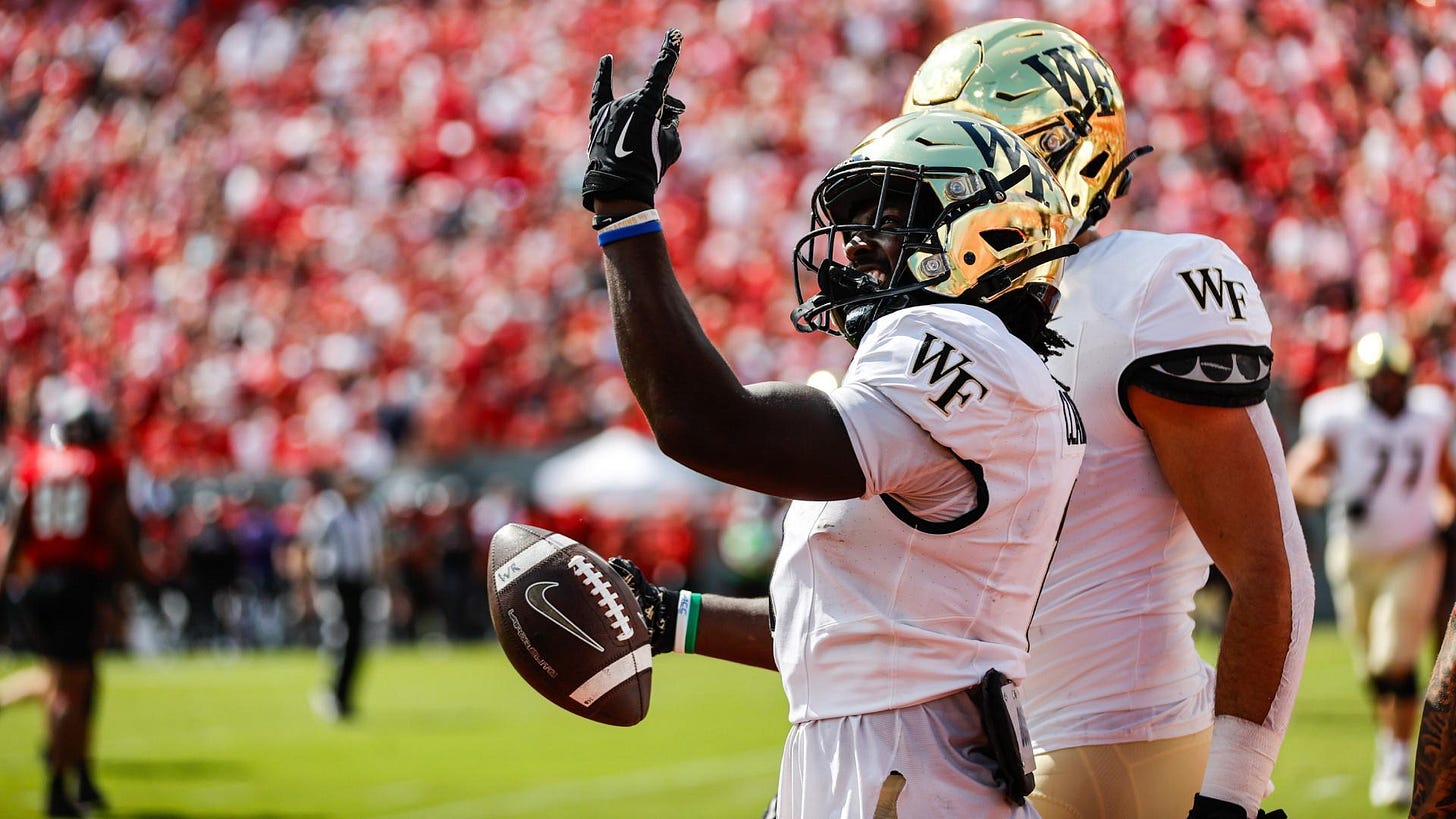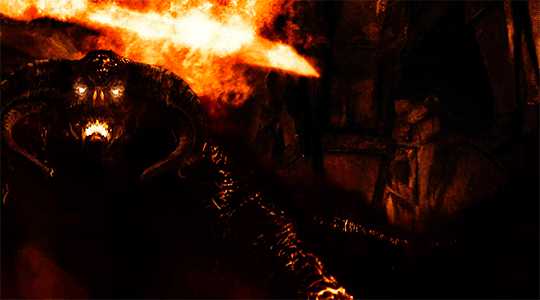A Demon of the Ancient World
A Balrog... A demon of the ancient world. This foe is beyond any of you...RUN!!!
- Gandalf, Lord of the Rings - FOTR
For those of you who may not have had the privilege of consuming my final RB rankings (yet), I will divulge a slight detail: I am high on Wake Forest RB Demond Claiborne this season. I feel like I’m the leader of his fan club for 2025, which I’m sure sounds silly given that he’s currently selected in the late first or early second rounds of CFF drafts.
But when I say I like Claiborne, I mean: when I was drafting in this year’s Golden Pig Invitational (a league I host for degenerate CFF players), I really did contemplate taking Claiborne at 1.02.
The ever-dedicated Sal Cusamano, who some of you may know, held the 1.01. He let me know the night before he’d be taking OSU’s Jeremiah Smith. I had assumed he would take Pitt’s Desmond Reid and so all week I was expecting to make a decision between Minnesota’s Darius Taylor, and Wake Forest’s Demond Claiborne. I eventually arrived at a conclusion that would have probably resulted in me selecting DC had Sal gone with Reid first.
In the end, he took the decision out of my hands, and yet—even then I gave it some thought. It makes me sad that I was unable to acquire more shares of DC this offseason, and none in the leagues I care about. I have a few bestball shares but I could care less about the performance of those teams and will likely forget about them as soon as the season starts.
For starters, I don’t really understand his ADP. He already averaged 19 PPG last year as Wake Forest’s guy, and is one of the few such players to return to CFB in the 2025 class. We all know this year’s RB group is historically weak, at least from a preseason profile perspective. Claiborne isn’t part of that group.
I imagine that the staff turnover is what is creating some animosity for drafters, but this need not be considered a negative. In fact, it’ll probably be a positive. One of the reasons Claiborne snuck up on so many people last year was that the previous WF staff did not have a good history at RB. In fact, it was one of the worst.
The new staff are better and the head coach actually said this recently:
40 carries he says? OK, I’m all in. That’s the type of workload that is a relic of the ancient world… some would say. I love it. Far too many cowardly coaches run committees these days if you ask me.
Claiborne was not only a workhorse in terms of carries last season, but he was also used as a receiver and as a returner. He even scored a 100-yard TD (and yacked all over the sideline after—that’s commitment).
I also love Wake Forest’s schedule this year. No Clemson, no Miami, not even Louisville, and their OOC slate includes Kennesaw State, WCU (FCS), Delaware, and Oregon State. Two of those four are recently promoted FCS programs, and another is an FCS program.
This team is ushering in a new QB. We don’t know how the passing game will look, but there are a couple of standouts at WR. They’ll get their targets I’m sure, but DC is going to be the main pig. You could think of a program like UNC last year with Omarion Hampton as a potential proof of concept with similar elements here.
Not only that, but DC was expected to either enter the NFL draft or hit the portal this offseason and he didn’t. His loyalty, I would think, will be rewarded.
Again, I think the source of most drafters’ apprehension is the new staff, so let’s take a closer look at these characters.
Coaching & System
RB1 PPG AVERAGE — HC: 11.9 — OC: 14.71 (half ppr)
Rob Ezell, most notably known from his Nick Saban impression, is the new OC. He came over from Southern Alabama. The head coach is Jake Dickert, who came over from Washington State. Dickert has already stated his intention above, and Ezell has also acknowledged Claiborne's talent and expected role in his offense this offseason.
Nonetheless, when looking at their histories in Table 1. below, the first thing that stands out is that neither coach has an extended history of play calling data to observe. That’s never ideal.
However, each coach has at least one solid season of RB production in their observed period: Dickert in 2022 with a 16.6 PPG RB, and Ezell with Fluff Bothwell (14.7 PPG) last season. Though it should be noted that neither of those runners was a high-volume guy and thus was more ‘fluky’ than a legitimate #VolumePig.
The reason I have such high conviction here is that 1) WF doesn’t have a lot of other options, 2) the coaches seem pretty aligned on what they want to do with DC, and 3) DC already had the role of workhorse on the team the year prior and chose to come back despite NFL interest.
I’m sure he didn’t like the feedback he got from the NFL and that’s the main driver for him coming back, but if he didn’t feel good about the plan the new staff laid out for him, this is a guy who was a 1.01 candidate to hit the portal this year. I’m sure there were at least a dozen programs tampering.
As far as what to expect in the play-calling patterns, Dickert’s WSU teams averaged a 54% pass rate, but those were often with an air-raid OC calling the plays. Ezell spent his first and only season as OC under the wing of former Southern Alabama OC Major Applewhite, who became the head coach last offseason. The Jaguars averaged a near 53% run rate in 2024, but it’s hard to isolate how much of that was Ezell’s influence.
My position is that this is going to be a run-heavy program, closer to what Southern Alabama averaged last year (and maybe even more like 55%), as the schedule is much more forgiving this year and WF shouldn’t find themselves overmatched. We also know DC can get it done in the air too, so even if they’re playing from behind, his profile is somewhat matchup-proof.
The biggest cause for concern is the offensive line. Wake Forest returns, according to CFB WinningEdge, less than 10% of the starting snaps from a year ago. Basically, it will be a new group of starters this year.
That said, I should mention that when a team doesn’t have a dominant offensive line to begin with, a high amount of turnover isn’t always the death sentence it initially appears to be. From that standpoint, I don’t know that I’m all that perturbed by the OL turnover.
I distinctly remember this time last year looking at UNC, with their 19% returning OL snaps, and considered that heavily when assessing Omarion Hampton, a player who I compared DC to above.
In this case, head coach Jake Dickert brought with him three offensive line transfers from Washington State, and I would expect at least a few, if not all, to start. They know the system, at the very least.
Another consideration is that QB Robby Ashford appears to be in the lead of WF’s QB competition. I wouldn’t view a decision here as final either way, as I do expect we will see both Deshawn Purdy and Ashford at different points in the season regardless. Ashford is not a good passer, but has shown to be dangerous on the ground. Purdy is a better passer, but not as mobile.
At some point, I really should do some sort of numerical analysis to observe what the effects on RB production actually are from having a running threat at QB.
On one hand, the most direct force to acknowledge is that the QB will absorb a lot of the team’s rushing production that otherwise would have likely funneled through the RB (particularly when considering red zone scores). This is an oversimplification, of course, as there’s nothing to say that those yards and TDs would have existed anyway without the running QB’s presence.
On the other—and especially for an otherwise potentially offensively challenged WF team—the fact that a whole other defender has to be committed to Ashford means one less to defend against the demon. To that end, the presence of a running QB may be felt through Claiborne’s efficiency stats on what is expected to be a large workload. This publication focuses on volume because it’s the easiest to project, but the golden juice of CFF is when high volume meets high efficiency—that’s when you get the best of the best performances.
Demond Claiborne (5’10, 195)
RUSHING STATS: 228 - 1048 - 11 (19.3 PPG)
The more I watch of DC, the more I like. This dude looks like a demon in the open field. Unlike Desmond Reid, Claiborne has the physical profile you want to see with an alpha RB; and unlike Darius Taylor, Claiborne doesn’t have an injury history. There also isn’t any obvious competition behind him for touches.
I would also posit that WF has a better schedule than Minnesota and Pitt (at least, judging from what we know in the offseason). Skipping Clemson and Miami is huge, and unlike last season, the Deacons don’t play Ole Miss in their OOC slate. The Rebels eviscerated the Deacons last season and DC scored less than 10 points total. It was one of his worst games of the season.
Clemson, Duke and Miami were the only other games where he failed to score at least 18 points. Like I said, he skips two out of those three and I’m not too worried about Duke. The talent discrepancy in that game won’t be the same as if it were versus Clemson or Miami.
In addition to Claiborne’s rushing escapades, he caught 23 of his 34 targets for 254 yards and two scores. In total, he finished the 2024 campaign with 1250+ yards from scrimmage (not including 277 return yards) and a total of 14 scores including special teams.
Those of you out there who are participating in this year’s Scott Fish Tadpole Bowls are (hopefully) well aware that special teams yardage counts for points in those formats. A player like this offers additional utility on that front. To be fair, so does Pitt’s Desmond Reid.
However—and again this is just a little primer for those who have yet to view the full RBs report—don’t be surprised to see Claiborne’s name ahead of Reid, and (notably) ahead of my former #1 RB Darius Taylor. ◾
If you enjoyed this content and would like to read more, I recommend joining the Pigpen, a community of thousands of degenerate college football fans:
Sample of 2018-2024, excluding 2020.







